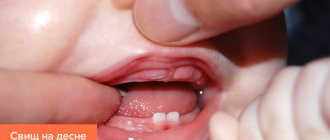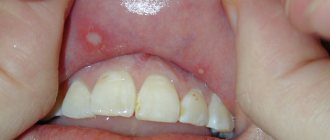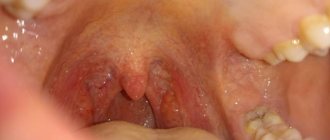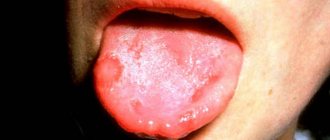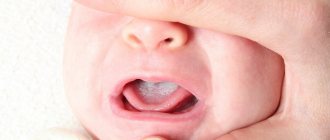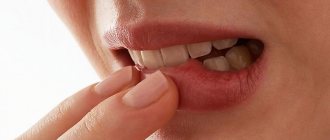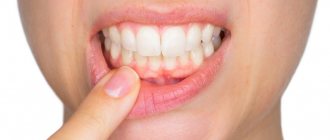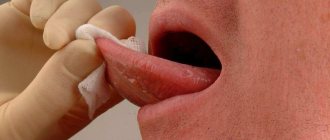What is a dental abscess and how to prevent this disease? In this article we talk about the causes, symptoms and treatment of abscess on the gums, as well as recommendations on how to reduce the likelihood of encountering a purulent infection.
Causes of a rash on the mucous membrane
In fact, there are many of them, ranging from the most harmless to the very dangerous. Let's look at each of the reasons in order.
Injury or burn of the mucous membrane
If a bubble appears on the gum, its appearance may be due to eating too hot food, drinks, or injury to soft tissues (for example, you bit them with your teeth while chewing food or falling). Various traditional methods of treatment can also pose a traumatic threat to the delicate mucosa. For example, using garlic or hydrogen peroxide can cause a burn. A bad habit such as smoking can also provoke the appearance of a rash on the mucous membrane, because when using cigarettes, the delicate mucous membrane constantly gets burned.
Soft tissues can be injured by incorrectly installed dentures or overhanging fillings, or incorrectly selected toothbrushes with hard bristles. A bubble with liquid on the gum may also appear due to an incorrect bite, because... in this case, you will again systematically damage the mucous membrane, and bacteria will begin to penetrate into the damaged tissue.
On a note! Injuries to the mucous membrane can lead to the appearance of a lipoma or wen in the mouth. This benign neoplasm occurs in the oral cavity quite rarely and causes mainly cosmetic problems. However, the wen tends to grow, which can lead to discomfort when opening the mouth and eating food.
Allergic reaction
Allergies can occur to various foods, medications, and personal hygiene products.
Dental diseases
Caries, pulpitis, periodontitis - these diseases, in the absence of timely treatment, progress and can lead to the formation of an inflammatory process at the apex of the tooth root and surrounding tissues, which in turn will provoke the appearance of purulent blisters on the gums. The presence of blisters in this case may indicate a gumboil, abscess, or fistula.
However, a purulent blister on the gum can appear even if you have your teeth treated by a dentist in a timely manner, fillings and crowns are placed. A problem may arise if the doctor did not properly disinfect and seal the root canals of the diseased tooth.
“After I had sinusitis, my gums ached and my tooth hurt, but there were no blisters or even redness on it, no caries or “holes.” Therefore, I did not go to the doctor for a whole year, until I felt that the tooth was loose and would soon begin to fall out. Then I went to the dentist, it turned out that I had a huge cyst at the root, which contained pus. The tooth had to be removed!”
Varvara Tm, from correspondence on the woman.ru forum
Sometimes pathology occurs in patients who have recently had a tooth removed. In this case, the blister may appear due to violation of aseptic rules during the removal procedure or due to the fact that the patient himself did not care about maintaining thorough oral hygiene during the rehabilitation process.
Infectious and viral diseases
You should always remember that the oral cavity is an excellent environment for the growth of bacteria, because... here the temperature, humidity, and also “food” are suitable for them. Bacteria can enter the oral cavity through the mouth when talking and eating, or through the nasopharynx. With a banal weakening of general or local immunity and insufficiently good oral hygiene, they easily occupy the teeth, gums, mucous membranes of the cheeks, palate, and trigger the inflammatory process. Therefore, if a bubble is inflated on the gum or a lot of them appear, then, most likely, the phenomenon is associated precisely with the predominance of pathogenic microflora over the beneficial one, and with the development of the following pathologies:
- activation of the herpes virus: in 50% of all cases, the appearance of water blisters on the gums is associated with herpes. It “dormants” in the body of 90% of all people on the planet, and under the influence of unfavorable factors (weakened immunity), it is activated,
- pemphigus: the etiology of the disease has not yet been fully elucidated, but scientists believe that it occurs when the immune system is weakened, and often appears as a complication against the background of tonsillitis, tonsillitis or influenza, oncology and chemotherapy. Also, its development can be triggered by a violation of autoimmune processes in the body. The pathology is diagnosed mainly in women aged 40-60 years1,
- herpes zoster or lichen planus: with this disease, a white bubble or neoplasm with transparent contents may appear on the gum,
- sore throat or diphtheria,
- stomatitis.
General diseases of the body
We can talk about autoimmune diseases, for example, HIV or AIDS, hepatitis, tuberculosis or syphilis, cancer. Problems with the gastrointestinal tract, thyroid gland, liver and kidneys can contribute to the appearance of a rash on the mucous membrane.
People with heart pathologies also develop tumors in the oral cavity. For example, with hypertension and damage to the blood vessels on the mucous membrane of the palate, the inside of the cheeks and the mouth, single hemorrhagic blisters2 bluish in color with bloody contents can form.
First signs
The first signs of blisters in the mouth:
- tingling, burning and itching in the mouth;
- the occurrence of pain;
- discomfort while chewing food;
- slight tissue swelling;
- dry mouth.
Based on external symptoms, the dentist can guess what caused the appearance of tumors on the mucous membrane:
- various microorganisms, fungi, infections;
- autoimmune conditions (chronic tuberculosis, hepatitis, HIV);
- allergies to food or drugs;
- consequences of a mouth burn from a hot drink or food;
- advanced conditions of periodontal disease, caries or pulpitis;
- exacerbation of inflammation of internal organs.
The dentist can make a more accurate diagnosis based on laboratory analysis of scraping the contents of the vesicle and the mucosal surface. The cause of blisters on the gums in half of the cases is the herpes virus.
Medical statistics say that active manifestations of this disease are observed in 80-90% of patients of different ages. Symptoms of the initial form or permanent relapse are most often diagnosed in children of the first year of life and elderly people with a weakened body.
If a rash appears in a child
Of course, in most cases, a bubble appears on a child’s gum for the same reasons as in an adult. But there are specific diseases that most often occur in children (they can also appear in adults, but much less frequently):
- chickenpox: it’s good if the baby gets chickenpox before he goes to school, because at a later age or in adulthood, this “childhood” disease is much more difficult to tolerate. Chickenpox is characterized by rashes all over the body, including transparent blisters that may appear on the gums or mucous membranes,
- candidiasis: with thrush, blisters appear on the gums and mucous membranes, and a thick, cheesy coating forms. This disease often occurs in newborns or children under 2-3 years of age, because they have not yet developed immunity,
- “Epstein's pearls”: a white bubble on the palate of a newborn does not indicate the presence of a serious pathology. Pediatric neonatologists urge parents not to worry about this, because After a few weeks the phenomenon goes away on its own. However, to make an accurate diagnosis, you need to visit a dentist or pediatrician,
- measles: at first, measles resembles a cold, the patient’s body temperature rises, and then a rash appears in the mouth, resembling semolina in appearance,
- scarlet fever,
- rubella.
On a note! A red bubble on the gum may appear in a child during the eruption of baby teeth. Such a neoplasm often occurs during the eruption of molars or incisors. It is red because it is filled with ichor.
A bubble in the mouth on the gum of a child is a reason not only to see a doctor, but also to strengthen general hygiene and oral hygiene. Remember that young children often try to put household items and toys into their mouths, and any bacteria from them can cause the development of an inflammatory process and complicate the course of the underlying disease.
Traditional recipes against inflammation
An affordable and effective way to reduce a blister on the gum is to apply a softened piece of propolis. This natural remedy contains many healing substances that eliminate itching and pain, and reduce swelling around the vesicle. The component can be mixed with Kalanchoe or aloe pulp, fresh honey.
For inflammation of the oral cavity, you can rinse it with decoctions of the following plants:
- sage and chamomile soothe mucous membranes;
- calendula and St. John's wort promote faster wound healing;
- oak bark will eliminate pathogenic microbes.
It is important to follow preventative rules to keep your gums healthy. Dentists advise eating as many dishes with fiber and vegetables as possible, replacing sweets with fruits, and eating sour-milk products. When brushing your teeth, do a small massage by pressing on the mucous membrane, this way the blood will flow.
Is it dangerous that a bubble appears on the gum?
How to determine the cause of problems by the type of rash
| Type of rash | Pathology | Other characteristic signs |
| A small, clear rash that causes severe itching and burning | Allergy | Discomfort usually improves with antihistamines. |
| A single bubble with clear liquid has inflated on the gum | Burn or injury | There will be noticeable redness and swelling of the mucous membrane around the bubble. The damaged area will “burn”, and the pain will be constant and aching. |
| Blood blister on the gum | Infection or pathologies of internal organs | Accompanied by an increase in body temperature, enlarged lymph nodes, and a general deterioration in health. |
| A purulent or white bubble on the gum near the tooth | Advanced dental disease | Pain when pressing on the tooth, swelling of the mucous membrane around the diseased tooth. Presence of a carious cavity or filling. The causative tooth may become loose. |
| Bubbles not only on the mucous membrane, but throughout the body | Pemphigus or chickenpox, measles, rubella, scarlet fever | After a while, the bubbles burst, and in their place wounds form, which then gradually heal. |
| Small blisters on the gums, on the inside of the mucous membranes of the lips and cheeks | Candidiasis or stomatitis | Accompanied by the appearance of a whitish coating on the tongue. The ulcers heal poorly, hurt, and make you refuse to eat. Burning, dryness and itching of the mucous membrane appear. |
Important! There are situations when a bubble in the mouth, for example, a fistula, opens on its own, making the person immediately feel better. However, this phenomenon is deceptive, and should not be a reason for you to postpone a visit to the doctor. Breakthrough of the tumor and release of purulent contents can cause intoxication of the body and blood poisoning.
Description
This unpleasant phenomenon can affect both adults and children, causing discomfort and pain when eating.
The appearance of white blisters on the gums as a result of damage to the oral mucosa contributes to burning and itching; such symptoms are especially painful for young patients.
It is not for nothing that experts say that the condition of the oral cavity is a kind of mirror that reflects the state of human health. You can provide first aid in the presence of such a pathology at home using traditional methods.
After treatment, preventive measures are required to prevent the recurrence of blisters on the gums. Externally, they appear as small transparent or white blisters, which are located in various places of the oral mucosa. Most often they appear in small groups. The inflamed areas become covered with a characteristic white or yellow coating.
First aid at home: do's and don'ts
What can you do
A bubble on the gum of an adult or a child in most cases “signals” the presence of some kind of disease. Therefore, there is no need to think about how to remove it yourself - this should be done by a doctor. However, before you see a specialist, who will make an accurate diagnosis and prescribe treatment procedures, you can alleviate the condition and prevent the infection from spreading throughout the body.
If there are painful sensations, then a cold compress (apply only on the outside of the cheek, after wrapping the cold compress in a soft towel or cloth) and taking analgesics will help get rid of them. To disinfect the oral cavity, you need to use rinses based on a decoction of herbs, soda and salt. For rinsing, you can use Miramistin and Furacilin.
What not to do
You should not use antibiotics without consulting a doctor. Also, under no circumstances should you heat the painful area, because such actions will only aggravate your situation, causing the rapid spread of infection throughout the body.
You cannot open a bubble on your gum yourself. You cannot treat it with brilliant green, iodine or potassium permanganate, alcohol tinctures, propolis, because this can lead to injury and burns of the mucous membrane, and an allergic reaction.
Traditional methods for treating blisters on the gums
Many herbs have analgesic and anti-inflammatory effects no worse than medications. For stomatitis or herpes, they will help remove blisters. This treatment is suitable in the initial stages of the disease. Herbs that help relieve pain:
- Oak bark;
- common chamomile;
- eucalyptus;
- calendula;
- series;
- celandine.
A decoction is prepared from any of the above herbs: 1 tbsp. l. pour a glass of boiling water, let it brew, filter, then rinse the mouth 3-4 times a day. Herbs can be mixed and made into collections.
What to do if a blister appears due to a burn or injury
If a bubble filled with clear liquid swells on the gum, then you need to know how to act correctly.
Firstly, you cannot open it yourself, because... then bacteria from saliva will penetrate into the open wound, and the inflammatory process will begin. And your main task is to ensure sterility of the neoplasm and promote rapid healing of soft tissues. To do this, you can apply compresses with Solcoseryl or Metrogyl Denta gel to the damaged area. You can lubricate the mucous membrane with aloe juice or sea buckthorn oil.
Secondly, while the damaged tissues are healing, try not to eat “irritating” foods (sour, spicy, hard, hot and cold).
Important! If the bubble opens without your help, then ensure it is sterile. To prevent infection from entering the wound, rinse your mouth after each meal with a soda solution or chamomile. The damaged area can be treated with Levomekol or Cholisal for speedy tissue regeneration.
Treatment for infectious diseases
Here, as with burns and injuries, you can’t do it on your own. You first need to see a doctor who will determine the type of disease and prescribe treatment. For example, for measles, herpes, candidiasis or stomatitis, treatment should be comprehensive:
- taking antiviral drugs,
- antifungal drugs,
- antiseptic treatment of the oral cavity,
- the use of local ointments,
- vitamin therapy: you need to strengthen the body from the inside to increase its resistance to bacterial attack,
- painkillers,
- diet correction,
- strengthening oral hygiene.
We deliberately do not list the names of drugs, because... For different infectious diseases, different medications will be effective, and only a doctor can determine the true cause of the pathology.
How is the treatment carried out?
Treatment in this case involves opening the blister surgically and subsequent removal of purulent masses through drainage. But this applies mainly to single neoplasms, while rashes are usually treated with external agents and rinses. In any case, first you need to undergo a diagnostic examination and identify the cause of the problem.
Treatment using pharmaceutical drugs
In the event that a blister on the mucous membrane is the result of an intensified herpes infection, a specialist may suggest the following therapeutic measures:
- taking antiviral drugs, such as Acyclovir,
- improving immune status with the help of multivitamin complexes and a course of immunoglobulin,
- treatment of the oral cavity with antiseptics and wound healing agents, which include Cholisalom and Metrogyl Denta.
If candidiasis is to blame, then the use of antifungal drugs will be required: Candida or, for example, nystatin ointment. A course of Clotrimazole and Amphoterecin tablets is also usually prescribed. When it comes to an abscess or periostitis, it is likely that surgical intervention will be required: an incision is made on the gum, an antiseptic treatment of the cavity is carried out and drainage is installed to ensure the outflow of purulent exudate. Additionally, a course of rinses and antibiotics is prescribed.
Therapy with folk remedies
Folk remedies will help reduce swelling and pain, but only after approval by your doctor. For example, a small piece of softened propolis, which should be applied to the sore spot, will help relieve swelling. It can also be mixed with aloe or kalanchoe pulp. As for rinsing with decoctions of medicinal herbs, the following plants have proven themselves well in this regard:
- chamomile and sage – effectively relieve inflammation,
- oak bark – helps eliminate pathogenic microorganisms,
- calendula and St. John's wort - have a wound-healing effect.
Calendula tincture will relieve pain
Dental experts advise paying attention to your usual diet. To prevent the development of gum diseases and their relapses, it is recommended to consume more vegetables and foods rich in fiber, fluoride and phosphorus.
When to go to the dentist
Inflammatory processes in the oral mucosa are a good reason to seek help from a specialist. Any attempts to cope with the problem on your own can lead to the development of serious complications, including tooth loss. Therefore, if you have a suspicious lump on your gum, even if it is not accompanied by any other symptoms, you should definitely see a doctor.
Prevention and further care
To minimize the risk of such an unpleasant phenomenon as a purulent blister or a whole scattering of blisters on the gum, it is necessary to arrange systematic visits to the dentist for preventive examinations - at least once every six months. You should also get regular professional cleanings at your dentist's office and remember to brush your teeth at least twice a day. After each meal, you should rinse your mouth with plain water and use dental floss. Following these simple rules will help virtually reduce the risk of developing inflammation in the oral mucosa to zero.
Preventative dental examinations will help avoid problems.
- According to the results of studies conducted by WHO.
What kind of help will the dentist provide?
If the cause of the appearance of a white bubble on the gum of a child or adult is an advanced dental disease, then the main tasks of the dentist are:
- disinfect the source of infection and prevent the spread of pus to neighboring areas and tissues,
- cure the root canals of a diseased tooth,
- save the tooth from removal.
With this pathology, the doctor opens the abscess and drains it, then cleans the root canals and puts a filling. However, in advanced stages of the disease, it will not be possible to do without an extraction procedure (tooth removal). Delay is especially dangerous for baby teeth, because... underneath them are the rudiments of permanent ones. Therefore, when a fistula, cyst or flux appears, in most cases the milk unit must be removed so that the infectious process does not cause pathologies in the formation of a permanent bite.
Associated symptoms
The characteristic accompanying symptoms directly depend on the specific type of problem and the cause that caused it. So, for example, a periodontal abscess causes acute painful sensations when pressed and any other mechanical irritation. In this case, the causative tooth may wobble a little, which is due to an increase in the volume of purulent exudate and its attempt to get out.
Under such circumstances, a person usually experiences a general loss of strength, and the body temperature may rise. Sometimes the abscess opens on its own, and then the new growth on the gum will gradually disappear without outside help. But this situation is very dangerous, because pus can lead to infection and intoxication of the body, so if a suspicious lump appears on the mucous membrane, you should urgently run to the dentist.
What happens if you don't get treatment?
A bubble on the upper or lower gum cannot be ignored. If the cause of its appearance is a fungus or herpes, then after a while the entire oral mucosa may become covered with blisters, which will cause pain and prevent you from fully eating food.
In the presence of untreated dental diseases, due to which a bubble with pus appears on the gum near the diseased tooth, the infection will primarily affect the root and surrounding tissues, spreading to neighboring units. This situation may lead to the need to remove teeth. If a cyst, abscess, fistula, flux occurs, pus through the bloodstream can spread to internal organs and even reach the brain, leading to sepsis, osteomyelitis, jaw fracture and death.
Characteristic sign of herpes
A characteristic feature of oral herpes is a sudden jump in temperature. The patient feels severe weakness in the lower extremities, lack of appetite and a desire to sleep. Small blisters with clear or cloudy liquid appear on the inside of the cheek or gum. These areas hurt when touched, and they burn when eating. After a few days, they open and bright red wounds form. If treated incorrectly, the rash reoccurs and begins to spread to the larynx and palate. This is fraught with severe complications for humans.
